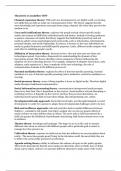Theorieën en modellen YDW
Channel expansion theory: With each new development in our digital world, we develop
new skills that can help us make our communication richer. The theory suggests that the
more knowledge and experience users gain from using a channel, the richer they perceive the
medium to be
Uses and Gratifications theory: explores why people actively choose specific media
outlets and content to fulfill their individual needs and desires. Instead of viewing audiences
as passive consumers of media, this theory suggests that individuals proactively seek out
media to satisfy various psychological and social needs, such as information, entertainment,
personal identity, and social relationship. In essence, it focuses on the ways individuals use
media to gratify themselves and fulfill specific purposes. Lastly, different media compete with
each other in satisfying people’s needs.
Diffusion of Innovation theory: focusses on how, why and what rate new ideas and
technologies spread. It provides a framework for understanding the dynamic of how
innovations spread. The theory identifies various categories of factors influencing the
adoption of a new technology process. For example, categories of adopters (innovators, early
adopters, early majority etc.), time, complexity of the new technology, the role of
communication channels in the diffusion process etc.
Parental mediation theory: explains the effect of Internet-specific parenting. Parental
mediation is a way of Internet-specific parenting (active mediation, restrictive mediation, co-
viewing)
Social presence theory: sense of being together is lower in digital media. Therefore digital
media disrupted traditional communication
Social information processing theory: communicators interpersonal needs prompts
them to try their best, this is dependent on the receiver. Social media is not just disrupting or
enriching our lives, it depends on the receiver and how they process information. An
individual needs special skills to learn these things, like interpretating cues, online.
Developmental tasks approach: hierarchic list of tasks; met through biological or social
development. In order for a person to adapt, these developmental challenges need to be met.
Risk and resilience approach: risk and protective factors explain differences between
children > cumulative risk model. Can help to explain why we may see greater effects of
media violence on some children than on others. The more risks a child encountered by a
child, the greater the likelihood of problematic functioning. Risk factors almost never occur
in isolation.
Theatre theory: frontstage and backstage. The stage we act on is life, and we assume
different roles when we interact with different people with a particular goal in mind: to
manage how they perceive us.
Cultivation theory: exposure to media across time has influence on our perceptions about
reality. The more time people spend ‘living’ in the television world, the more likely they are
to believe the social reality portrayed on television.
Agenda-setting theory: ability to influence the salience of topics on the public agenda.
Three levels demonstrate that the news media can determine what we think, how we think
about a given object, and how we associate different elements to make sense of the world.





